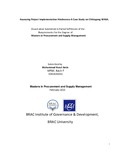Assessing project implementation hindrances: a case study on Chittagong WASA

View/Open
Date
2015-02Publisher
BRAC UniversityAuthor
Amin, Muhammad NurulMetadata
Show full item recordAbstract
A handsome share of government expenditure is channeled through the annual development program (ADP) which normally undertakes numerous construction and other types of procurement activities through the implementation of development programs and projects. Government projects are undertaken through the involvement of a number of ministries, divisions and different implementing agencies with a long and vigorous approval process. During project preparation and implementation, procurement has a huge implication. The procurement system adopted by the government has also played a significant role on the efficiency and effectiveness of the project implementation. The reforms initiatives undertaken by the government in order to bring efficiency, economy and effectiveness in the public procurement system started in the year 2003 through the introduction of Public Procurement Regulations (PPR‟2003). To reinforce the improvement measures in the public procurement system, the House of the Nation enacted the much desired law, the Public Procurement Act „2006. Under the Act of 2006, the Public Procurement Rules 2008 was framed and issued which is now widely observed in all government purchase.
The main issue of this study is to identify the factors that restricts for successful implementation of the project for the government projects that follow PPR with projects that are funded by international development partners that follow specific guidelines of the donor partners. To that end this study concentrates on a single project namely, “Karnaphuly Water Supply Project, phase-1” project implemented by Chittagong Water Supply & Sewerage Authority.
Project Challenges can be measured by assessing the performance of the project on some key measurable parameters. These parameters are – the cost of the project, the time of project implementation and construction quality. Since there is no way of measuring efficiency and effectiveness of the project directly, these three project parameters have been measured by conducting survey among the implementers of the project and interviewing the key informants.
Those parameters then have been used to evaluate the efficiency and effectiveness of the project implementation and compared with other CWASA projects. Also to have an in depth knowledge of the project characteristics interview with the key informants‟ of the project was also conducted who provided valuable information about the project concerned and also the characteristic features of other projects.
To assess the challenges of the project survey questionnaire has been developed focusing on the key performance indicators of the project namely, the cost, time and quality of the project construction. The inconsistency in following some of the provisions of PPR has added complexity in contract approval and management of the project which resulted in delayed project implementation.
